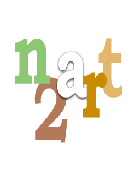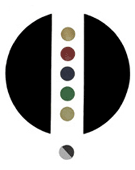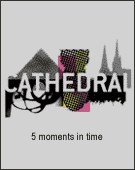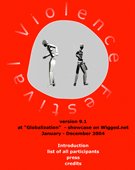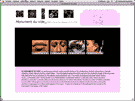Curatorial discourse
Conversation between Atle Barcley, Peter Hagdahl, Martin Pingel, Perttu Rastas and Katrin Sigurdardottir.
- In the process of realizing n2art, it seems that people have again and again gotten stuck in a definition crisis. Is n2art a web-gallery, an artbase, an exhibition, a funding structure...??? Is there any significance or need to agree on one definition, and if so, what should this definition be? If not, what is the function of n2art to you?
Perttu Rastas: There is not a good, workable definition of netart within the concept of digital media. We are immersing every thing from our cultural past to new media and we're in a great mixing process where we can open our archives to whatever they are to the productive world. Definitions and statements are needed for official and marketing reasons but art it self is always resistant, faster to move ...
Full Description
Curatorial discourse
Conversation between Atle Barcley, Peter Hagdahl, Martin Pingel, Perttu Rastas and Katrin Sigurdardottir.
- In the process of realizing n2art, it seems that people have again and again gotten stuck in a definition crisis. Is n2art a web-gallery, an artbase, an exhibition, a funding structure...??? Is there any significance or need to agree on one definition, and if so, what should this definition be? If not, what is the function of n2art to you?
Perttu Rastas: There is not a good, workable definition of netart within the concept of digital media. We are immersing every thing from our cultural past to new media and we're in a great mixing process where we can open our archives to whatever they are to the productive world. Definitions and statements are needed for official and marketing reasons but art it self is always resistant, faster to move somewhere else. Netart is so young concept and there are lots of different paths to come in the netart field. To make a BIG statements in the now when everything is still developing is not the correct way to look at it.
I think it's good if we don't or can find one name or title for networked art because what is open is possible.
Peter Hagdahl: I agree with Perttu. The discussion and confusion of the identity of netart and n2art is a symptom of a new field in art and I think that it is a productive confusion which keeps doors open. Define netart to narrowly one risks exclusion. I think it is important though to insist on netart as art done with the net as a media to keep a healthy distance to all other art-on-the web activities as shops that sells art etcetera.
Atle Barcley: Net art is, like other art, a field of discourse. There is no generic quality that makes something net art. Often the problem is the attempt of defining looks for generic qualities where these do not exist. For a net artists this is not a problem. You don't have to know how to define net art before you can do a piece. Projects like RTMark for example were never meant to be art anyway.
When trying to understand net art I want to point at what I think is the main attribute. In traditional visual art the core facility is the gallery and the museum with the art magazines playing an important role. In net art the central facility is the mailinglists. These mailinglists are information channels, fora for discussion, publishing channels for mail art etc. These mailinglists are moderated very liberally compared to galleries, concerthalls, seminars and art magazines. They are also not always dedicated to (net) art. Through these mailinglists, net art (discourse) is linked to other fields like political activism, theory of media and net culture and pan-national networking in a broader sense. These networks are often, but not always, linked to the art world, i.e. Nettime was established on the Venice biennale. To be aware of the fact that net art did not come from art establishment, and that net art is not "independent" from other fields is, I think, quite important when looking at net art.
Older terms like the gallery and exhibitions come from the outside. They are coming from the established art world and it immediately raises the question about whether net art is structured in a significantly different way than traditional visual arts. I think its quite important not to export too many traditional terms and definitions to net art without first make sure they are relevant. Better to keep a field undefined than to stick all the wrong labels everywhere.
I have very limited influence on where n2art is going but we sure need a base for funding net art in this region. n2art's (and now NIFCA's) connections to the Nordic political system is a good start for this.
Katrin Sigurdardottir: I find it easiest to discuss netart as some undefined area of experimentation with a backbone in the traditional arts, as well as in the constantly developing new technology. I think where a lot of people run into trouble is when they try to understand netart within simplistic definitions of the visual art tradition. It seems that we are constantly stuck in some old and conservative notions of what the visual art tradition presently is. I think in many ways it is no coincidence that the visual art establishment - like the Venice Biennale, Documenta in Kassel, the DIA Foundation and NYC MOMA - have taken a great part in the initiation, formation and support of netart. Book publishers have not done the same - to name an example - nor have record labels. Even though it might seem simplistic and unpopular, I believe that this can be partly explained by the fact that there is very little happening in netart that cannot be seen to have some predecessor in the 20th century visual art tradition. In dada, in postmodernist activism or media usage, in fluxus, in video art - to name some examples. I think here is an opportunity to confirm the notion that we all seem to subscribe to, but often forget in speech, namely that visual art does not simply mean a formalist rectangular, "brand-name" commodity. This strand of art is of course live and well - and quite dominant, but this is only one part (and perhaps not the most significant part) of the 20th century legacy in visual art. This is not to say that netart is somehow only illustrative of the visual art tradition, but I think it is as much in direct descendence of it, as it is of anything else.
This is also not to undermine the significance of self-initiated, autonomous establishments, like Rhizome. It is important to draw a line between conceptual/aesthetic origins of netart, and its tendencies as far as organisation and establishment. In netart there seems to be an opportunity to provide or solidify independent initiatives that potentially function based on other ground rules than the gallery and the museum. But the art-establishment archetypes are thrust upon netart through every means possible. There is something interesting to the fact that it doesn't always seem so easy to begin within the visual arts tradition and not end up there as well...
On the issue of naming this project or agreeing to a definition of it, I think it will just define itself. We don't know exactly beforehand what it will be, it is an experiment, an improvisation - in the hands of artists, curators and directors... and then of course the net-audience. You cannot ever be sure what ends up happening when you invite the public to participate in the work. All the works in n2art are interactive so we will see...
Martin Pingel: I do not believe that it is necessary to agree on one definition of netart. Actually, I don't think that there is much difference in working with netart and working with other forms of art. Art is a manifestation of consciousness regardless of the medium. If you say that the n2art is a gallery or is something else, is only a question of if you wish to use traditional metaphors in the world of netart. On the other hand, it is important to emphasise that netart does contribute to the intentions of modern art to expand the definition of art. N2art will prove to be an important element in this development.
- Can you describe shortly the process of selecting the artists for n2art? What was the criteria sought, and in which way was the curatorial process different in each country? Why was it different?
Atle Barcley: I made a public call for proposals in Norway, in addition to contacting people I knew where doing interesting works. The reason was simply that I didn't know for sure if I knew about what was going on. A lot of interesting net art is done by people who are not recognized by the offline art world. Then what I was looking for both in Norway and in our discussions in the curatorial board was networking and community projects. Exchanging and sharing of resources, organizing and structuring communities, exploring and thinking about dynamic networks.
Katrin Sigurdardottir: In Iceland I decided to make a public call for works as well. There has been so little organizing or even publicizing of Icelandic netart/ists, that I didn't feel informed enough to make a decision from my own resources. We ended up selecting two proposals that are quite different from each other. Thoroddur Bjarnason
Work metadata
- Year Created: 2001
- Submitted to ArtBase: Thursday Apr 26th, 2001
- Original Url: http://n2art.nu
-
Work Credits:
- Pia Vigh, creator
Take full advantage of the ArtBase by Becoming a Member
